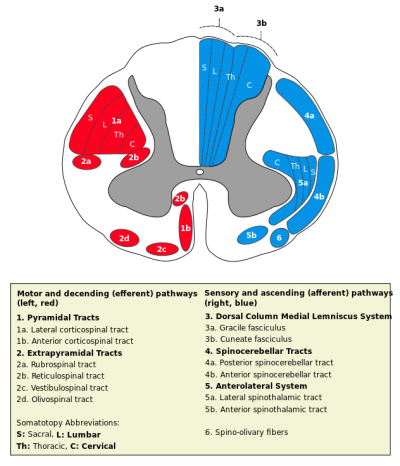Vestibulospinal Tract
Original Editor -
Kate Sampson
Top Contributors - Kate Sampson, Lucinda hampton, Wendy Walker, WikiSysop and Kim Jackson
Description[edit | edit source]
The Vestibulospinal tract is infact made of two tracts, the lateral and medial. Each tract is responsible for increasing antigravity muscle tone in response to the head being tilted to one side [1] Fibres of the vestibulospinal tracts, the vestibular neuclei, are associated with the cerebellum, which therefore can subsequently result in the cerebellum indirectly influencing control on the spinal control [2] In addition these pathways recieve information from the labyrinthine system.[3]
Anatomy [edit | edit source]
Lateral Vestibulospinal Tract[edit | edit source]
Origin[edit | edit source]
- Lateral vestibular nucleus (Deiters' nucleus) [1]
Course / Path[edit | edit source]
- Fibres descend ipsilaterally though the anterior funiculus of the same side of the spinal cord, synapsing on the extensor antigravity motor neurons.[1][3]
Medial Vestibulospinal Tract[edit | edit source]
Origin[edit | edit source]
- Medial and inferior vestibular nuclei[1]
Course/ Path[edit | edit source]
- Descends bilaterally in the medial longitudinal fasciculus
- Synapses with the excitatory and inhibitory neurons of the cervical spine. [1]
Function[edit | edit source]
Lateral Vestibulospinal Tract[edit | edit source]
- Excitation on extensor motor neurons controlling muscle tone in antigravity postural muscles[3]
- Inhibits flexor motorneurons ipsilaterally and facilitates flexor activity ont he contralateral side [4]
- In gait selective activity is notes in the motor neuron of the quadriceps of the leading leg following heel strike and is maintained through stance phase[1]
Medial Vestibulospinal Tract[edit | edit source]
- Innervates interneurons in the cervical and upper thoracic spine. [5]
- Main function is to stabilise the head in relation to the body
- Head righting relexes. These are responsible for keeping the head and gaze horizontal
- Eye righting reflex (Vestibulo-ocular reflex) This origniates in the ascending medial longitudinal fasciulus and extends to the extraocular muscles of the eyes. The horizonal position of the eyes when the head is an upright postural set is caused by cancelling of the tonic acitiy of the deiteroocular pathways.[1] It is therefore able to keep the eyes still while the head moves, allowing images to focus on the retina [5]
Pathology
[edit | edit source]
Leisons/ impairments distrupting the Vestibulospinal Tract can result in:
- Ataxia and hypermetria [6]
- Impaired postural control with substitution of other senses to compensate for impairment. E.g. Light touch & Vision[6]
- Animal studies have suggested that there is an underlying balance between descending systems controlling stretch reflex activity: the dorsal reticulospinal tract (inhibitory) and the facilitatory medial reticulospinal and vestibulospinal tract (facilitatory).[7] If this is impaired it could cause further symptoms of the upper motor neurone syndrome.
- Impairment to the medial vestibulospinal tract is also suggested to impair the vestibular-evoked myogenic potential resulting in spontaneous nystagmus, gaze-evoked nystagmus and tilt of the subjective visual vertical [8]
Recent Related Research (from Pubmed)[edit | edit source]
Failed to load RSS feed from http://www.ncbi.nlm.nih.gov/entrez/eutils/erss.cgi?rss_guid=1bq4FUNF5: Error parsing XML for RSS
Resources[edit | edit source]
References[edit | edit source]
References will automatically be added here, see adding references tutorial.
- ↑ 1.0 1.1 1.2 1.3 1.4 1.5 1.6 Fitzgerald MJT, Gruener G, Mtui E. Clinical Neuroanatomy and Neuroscience. Fifth Edition. Philadelphia:Elsevier Saunders, 2007
- ↑ Carpenter R, Reddi B. Neurophysiology. A conceptual approach. Fifth edition. London: Hodder Arnold, 2012.
- ↑ 3.0 3.1 3.2 Crossman AR, Neary D. Neuroanatomy. An illustrated colour text. Third Edition. Philadelphia:Elsevier ,2005
- ↑ Dietz V. Human neuronal control of automatic functional movements: interaction between central programs and afferent input. Physiol Rev 1992; 72: 33-69
- ↑ 5.0 5.1 Gjelsvik BEB. The Bobath Concept in Adult Neurology. Germany: Thieme, 2008
- ↑ 6.0 6.1 Horak FB. Postural Compensation for Vestibular Loss. Ann N Y Acad Sci 2009; 1164: 76–81.
- ↑ Trompetto C, Marinelli L, Mori L,Pelosin E, Currà A, Molfetta L, Abbruzzese1 G. Pathophysiology of Spasticity: Implications for Neurorehabilitation. BioMed Research International 2014;
- ↑ Kim S, Lee HS, Kim JS. Medial vestibulospinal tract lesions impair sacculo-collic reflexes. Journal of Neurology 2010; 257:5: 825-832







